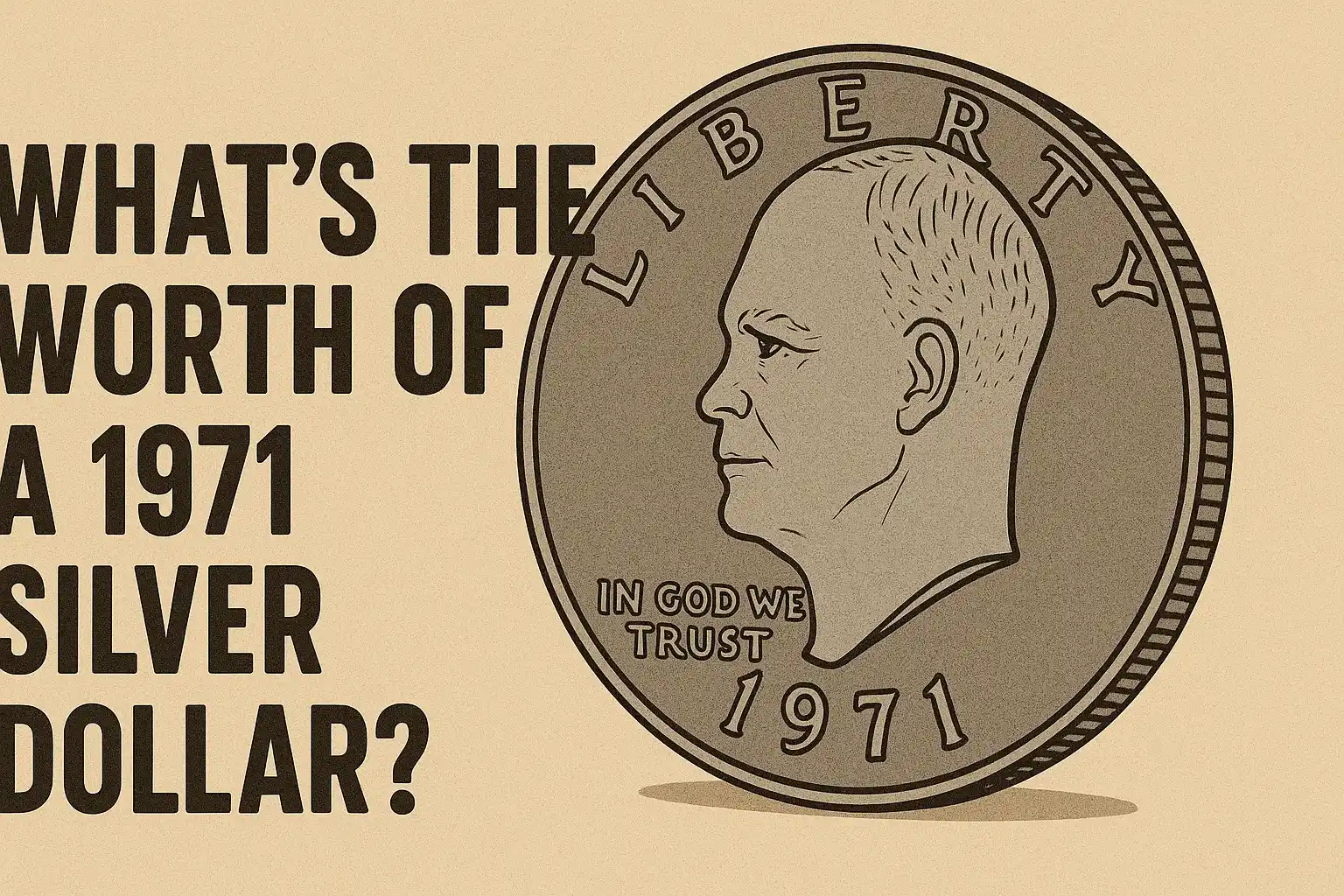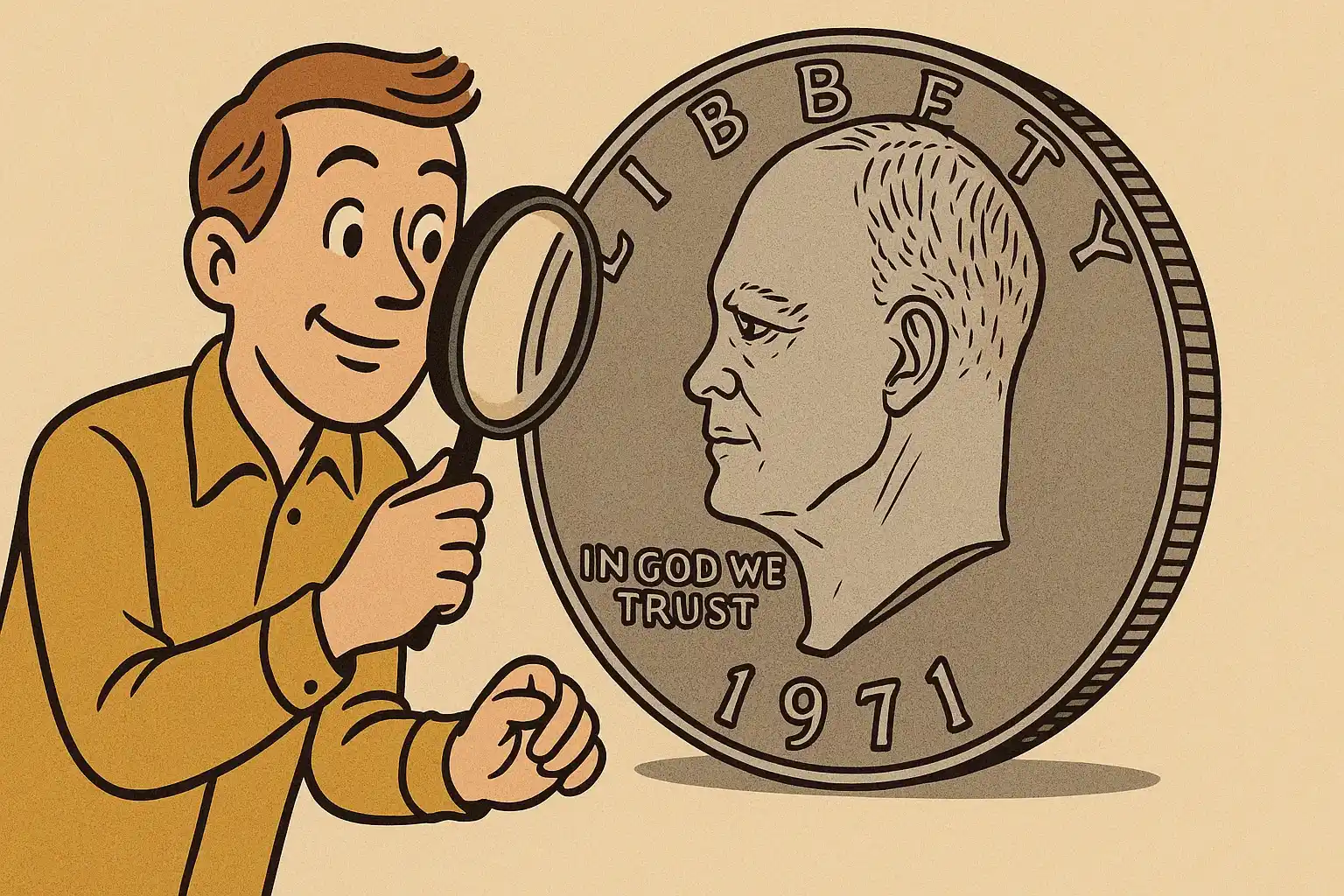It’s hefty. It’s bold. It’s got Dwight D. Eisenhower staring proudly into the distance on the front and an American eagle landing on the Moon on the back. No, it’s not science fiction—it’s the 1971 Eisenhower dollar, a coin born at the crossroads of patriotism, space-age ambition, and numismatic curiosity.
If you’ve stumbled upon one of these metallic giants—or inherited a mysterious silver dollar from your granddad—you might be holding more than just a piece of change.
But how much is it really worth today? Well, that depends on which version you have. Some are silver-laced collectibles; others are common copper-nickel coins with little value beyond their weight.
Let’s crack open the story and real 1971 silver dollar value.

Chapter One: A Coin with Cosmic Ambition
The Eisenhower dollar wasn’t just another coin—it was a statement. After a 36-year hiatus in dollar coin production, the U.S. Mint returned in 1971 with a design that honored both President Eisenhower and the Apollo 11 mission. That’s why the reverse of the coin doesn’t just show a bald eagle—it shows an eagle descending onto the Moon, olive branch in claws, just like the mission’s insignia.
The coin was a tribute to two American legends:
- Ike, the general-turned-president who helped shape post-war America.
- Apollo 11, a crowning achievement of human ingenuity and American spirit.
But here’s the kicker: although it’s called the “silver dollar,” most 1971 Eisenhower dollars contain no silver at all.
General Specifications (All 1971 Eisenhower Dollars):
- Obverse Design: Portrait of President Dwight D. Eisenhower
- Reverse Design: Eagle landing on the Moon (Apollo 11 insignia), designed by Frank Gasparro
- Diameter: 38.1 mm (1.5 inches)
- Edge: Reeded
- Designer: Frank Gasparro (both obverse and reverse)
Metal Composition:
| Version | Metal Composition |
| Clad (1971, 1971-D, 1971-S Proof) | Outer layers of 75% copper, 25% nickel over pure copper core |
| Silver (1971-S Uncirculated & Proof) | Outer layers of 80% silver, 20% copper over a core of 79% copper and 21% silver (Approx. 40% silver overall) |
Weight & Silver Content:
| Version | Weight | Silver Content (Approx.) |
|---|---|---|
| Clad | 22.68 grams | 0.00 oz |
| 40% Silver (1971-S) | 24.59 grams | 0.3161 oz silver (approx.) |
Mint Marks and Mints:
| Mint Mark | Mint Location | Coin Type |
| None | Philadelphia | Clad for circulation |
| D | Denver | Clad for circulation |
| S | San Francisco | Clad Proof and 40% Silver (Proof & Uncirculated) |
Packaging (For Silver Collector Editions):
- “Blue Ike” – 1971-S 40% Silver Uncirculated coin in a blue envelope with a blue U.S. Treasury seal.
- “Brown Ike” – 1971-S 40% Silver Proof coin in a brown faux-leather box with a U.S. Mint seal.
Chapter Two: Silver or Not—That Is the Question
To separate the valuable from the common, you must know your mintmarks and your metals. There are four types of 1971 Eisenhower dollars—and only two have silver content.
How to Tell What You’ve Got:
| Mint Mark | Mint Location | Material | Distribution |
| No Mint Mark | Philadelphia | Copper-Nickel Clad | Circulation |
| D | Denver | Copper-Nickel Clad | Circulation |
| S | San Francisco | Copper-Nickel Clad | Proof |
| S | San Francisco | 40% Silver Clad | Collector’s Sets Only |
Key tip: The 1971-S Silver Dollar came in two special editions sold by the Mint:
- Uncirculated “Blue Ikes” (in blue envelopes)
- Proof “Brown Ikes” (in brown presentation boxes)
These were never meant for regular pocket use. If you have one that looks shiny and flawless or comes in old mint packaging, you may just be holding silver.
Chapter Three: What’s It Worth Today? (2025 Values)
Let’s talk numbers. While most 1971 Eisenhower dollars fetch around $1–2 in circulated condition, some versions and mint-condition coins tell a different story.
| Coin Type | Grade/Condition | Estimated Value |
| 1971-S Silver Proof | PR65–PR69 | $15 – $45 |
| 1971-S Silver Uncirculated | MS60–MS65 | $12 – $30 |
| 1971-D / 1971 (Clad) | Circulated | $1.10 – $1.50 |
| 1971-D / 1971 (Clad) | MS65+ | $10 – $20 |
| 1971-S Clad Proof | PR67–PR69 | $5 – $12 |
| Error Coins | Varies | $100 – $3,000+ |
Chapter Four: Rare Errors & High-Value Surprises
Most coins are struck to perfection. But sometimes, the Mint makes a mistake—and collectors rejoice.
1971 Eisenhower Dollar Errors to Watch For:
- Doubled Die Obverse (DDO): Eisenhower’s features or the date may look blurred or doubled.
- Off-Center Strikes: Coins not properly aligned in the press—freakish but valuable.
- Wrong Planchet Errors: Some rare 1971 Ikes were struck on leftover silver blanks from other coins. These are extremely rare and can be worth thousands.
If your coin looks odd, heavier, or has a strange tone—get it authenticated.

Chapter Five: Is It Worth Getting Graded?
Yes—if your coin is:
- Uncirculated and pristine
- A 1971-S silver version
- An error coin or variant
- Has strong eye appeal or unusual luster
Third-party grading services like PCGS and NGC can verify condition and authenticity, which often increases the coin’s resale value dramatically.
Conclusion
The 1971 Eisenhower dollar is more than a hefty piece of metal—it’s a symbol of American achievement, nostalgia, and sometimes, unexpected value. While most are worth only a few bucks, the silver versions and rare errors can surprise even seasoned collectors.
So, before you toss it into a coin jar or let it gather dust, give that Ike dollar a closer look. You might just be holding a miniature piece of moon-landing history… and a tidy little fortune.
Want to be sure what you’ve got? Use the Coin ID Scanner app to photograph your 1971 dollar and instantly check its metal composition, a rare error, or worth sending in for grading. It’s like having a numismatist in your pocket.
